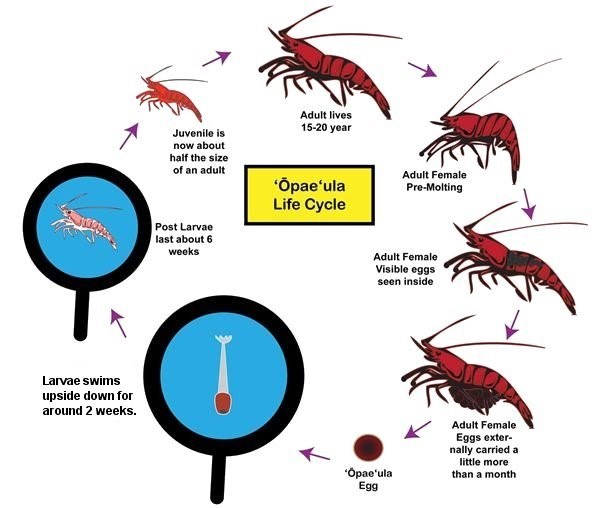Last updated: December 24, 2020
Article
Anchialine Pools

Anchialine Pools and ‘Ōpae‘ula
Anchialine pools are unique aquatic ecosystems where water pools in the crevices and cracks of lava near shore. They are made up of brackish water - a mixture of fresh groundwater that comes from the rain on the mountain, filtered through porous lava rock and salt water that is linked to the ocean by subterranean tunnels. Water levels in the pools often fluctuate in response to ocean tides due to the coastal location and connection with the ocean.
Fun Fact:’An-key-ah-lin’ from Greek ankhialos ‘near the sea’. |
Many species rely on the anchialine pool habitat for survival. One of the most common and well known species are ‘ōpae‘ula, (Halocaridina rubra), or red shrimp. ‘Ōpae‘ula are indigenous to the Hawaiian islands and live in the dark crevices in the water table below the pools. They are quite small, growing no longer than a half inch in length filter feeding on algae, plankton, bacteria, and diatoms in water. ‘Ōpae‘ula can carry about 12 fertilized eggs under their abdomen for a brood period of about 38 days. They reproduce one to two times per year. Lifespan of ‘ōpae‘ula is 10-15 years of age, an unusually long lifespan for a tiny crustacean. Their colors range from red, pink, white, yellow/clear, orange, and pale cream.There are an estimated 1000+ pools worldwide and a vast majority of these pools are found on the West coast of Hawai‘i Island. The state of Hawai‘i is the only state in the entire US that has these brackish water anchialine pools. Kaloko-Honokōhau National Historical Park alone harbors over 200 of them and early settlement was possible in West Hawai‘i because of the accessibility of fresh water in the pools. Not only are they a unique natural resource but also a very important cultural resource.

opeula.cu.uk
‘Ōpae‘ula Life Cycle
- Molting: After molting an adult female is able to receive the sperm from males
- Eggs: The female broods for 30-38 days before larvae hatch
- Larvae: The larvae are only about 1/8” long. They do not have developed appendages and survive on yolk sac. This stage lasts about 13-15 days
- Post-Larvae: This stage is also called the megalopal stage. Larvae develop swimming legs and begin feeding on alg
- Juvenile: Antennae are still growing at this stage and feeding is very important in order to become an adult. After 7 weeks, juveniles usually ecome adults.Adult: Once an adult, ‘ōpae‘ula are about 1/2” in length. They are viable for reproduction and females can reproduce more than one time per year. Adults can live from 10-15 years if proper habitat is available.

Fun Fact: ‘Ōpae means shrimp and ‘ula means red
Native Hawaiians used ʻōpaeʻula as fish food in their fishponds. It is believed that ʻōpaeʻula used to be so abundant in the anchialine pools that, from a distance, the water in the pools appeared to be red. Even though ʻōpaeʻula are extremely hardy and capable of tolerating a wide range of salinity levels and temperatures, ʻōpaeʻula today live in much lower densities and are coping with habitat loss due to human activities.
Threats
The introduction of non-native (introduced) species to anchialine pools are one of the largest threats to ‘ōpae‘ula. Non-native fish such as tilapia, mosquitofish, and guppies prey upon ‘ōpae‘ula. Another large threat to ‘ōpae‘ula today is habitat loss. Groundwater resources are impacted by water withdrawal for human use, pollutants and nutrients that enter the groundwater, interruptedgroundwater flow from coastal development. Habitat and rare species decrease or may disappear altogether. One of the things people can do right now is stay out of these sensitive areas. Sunscreen and other body oils can change the water quality and potentially affect creatures like ‘ōpae‘ula.)
Historical and Cultural Significance of ‘Ōpae‘ula
According to an ancient legend, a Hawaiian princess named Popoalaea fled from her cruel husband, the Chief Kakae, and hid on a ledge just inside the underwater entrance to the cave at Waianapanapa. A faithful maid sat across from the princess, fanning her with a feather kahili, a symbol of royalty. Noticing the reflection of the kahili in the water, Chief Kakae discovered Popoalaea’s hiding place and killed her. At certain times of the year, tiny red shrimp appear in the cave's brackish pond turning the water red. Some say it is a reminder of the blood of the slain princess.
Watch this video about Anchialine Ponds and ‘Ōpae’ula! :
https://www.nps.gov/media/video/view.htm?id=3A0BD53F-EE9A-30F9-ACFC0CE94917A8C4
Click the link below for a fun ‘ōpae‘ula activity! :
https://dlnr.hawaii.gov/dofaw/files/2017/04/%C5%8Cpaeula-Finger-Puppet.pdf
